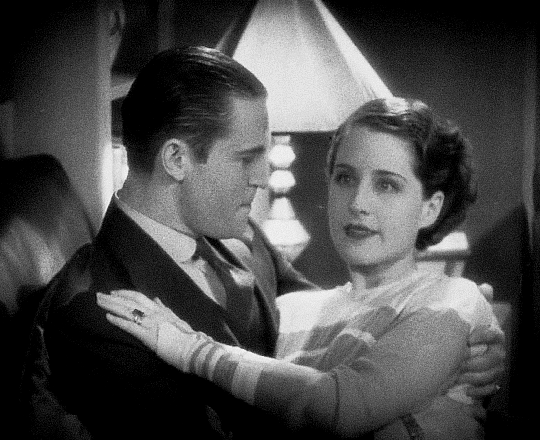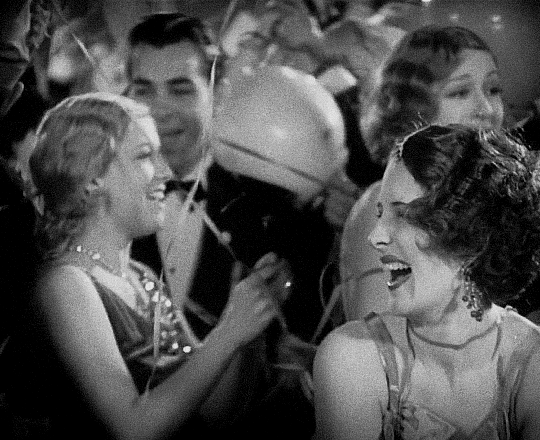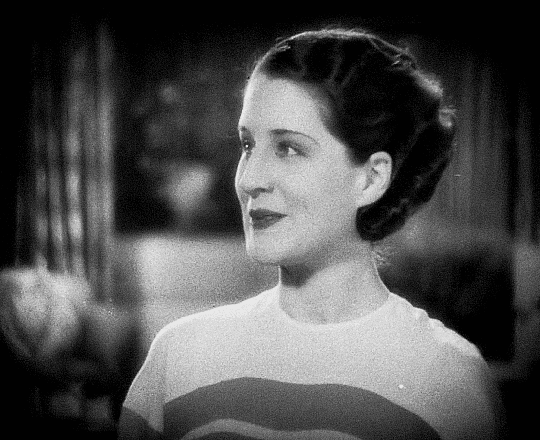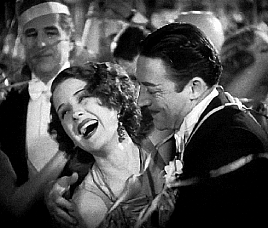As heroínas dos filmes feitos antes do Código
Hays eram quase sempre personagens femininas admiráveis. Navegando em um mundo
masculino e tendo como principal arma seu corpo, elas eram sensuais, ousadas e
provocantes. E estes três adjetivos são perfeitos para descrever a protagonista
de “A Divorciada”, de 1930.
The heroines of pre-Code films were almost always remarkable female characters. Navigating a man’s world having as their main weapon their body, they were sensual, bold and provocative. And these three adjectives are perfect to describe the lead in 1930’s “The Divorcee”.
Jerry (Norma Shearer) é cobiçada por muitos
homens, mas o primeiro a pedi-la em casamento é Ted (Chester Morris). Ela
aceita o pedido e eles se casam. Três anos após o casamento, eles parecem viver
em perfeita harmonia... até que Janice (Mary Doran), uma velha conhecida de
Ted, chega à festa de bodas do casal.
Jerry (Norma Shearer) is wanted by many men but the first to propose is Ted (Chester Morris). She accepts the proposal and they get married. Three years after the wedding, they seem to be perfectly happy… until Janice (Mary Doran), an old acquaintance of Ted’s, arrives at the party being thrown for their anniversary.
Quando ela descobre sobre Ted e Janice, Jerry
encontra consolo nos braços do melhor amigo de Ted, Don (Robert Montgomery),
que gosta dela mais do que como amiga. Ela então pede o divórcio de Ted,
experimentando uma liberdade inédita como a nova ex-esposa.
When she learns about Ted and Janice, Jerry finds consolation with Ted’s best friend Don (Robert Montgomery), who likes her more than as a friend. She then proceeds with the divorce from Ted, experiencing unmatched freedom as the new ex-wife.
Em suas aventuras, Jerry re-encontra Paul
(Conrad Nagel), que era apaixonado por ela quando ela anunciou seu noivado com
Ted. Paul ficou tão chateado com a notícia que se embebedou e se envolveu em um
acidente de carro que deixou o rosto de Dorothy (Helen Johnson) desfigurado.
Paul então se casou com Dorothy movido pela culpa. Quando ele re-encontra
Jerry, descobrimos que Paul nunca a esqueceu, e agora vê a oportunidade de
deixar Dorothy e se casar com Jerry.
In her adventures, Jerry re-encounters Paul (Conrad Nagel), who was in love with her when she announced her engagement to Ted. Paul got so upset with the news that he got drunk and got involved in a car accident that left Dorothy (Helen Johnson) with a disfigured face. Paul then married Dorothy out of guilt. When he meets Jerry again, we learn that Paul never forgot her, and now sees the opportunity to leave Dorothy and marry Jerry.
Em certo momento, depois de ser perguntada o
que havia de errado com ela, Jerry responde: “Só estou tentando me agarrar à
maravilhosa latitude do ponto de vista de um homem”. Ela está claramente
falando sobre os dois pesos e duas medidas a partir dos quais homens e mulheres
são julgados. Para um homem, um caso extraconjugal “não significa nada”, mas se
é a mulher que trai, ela é julgada sem piedade.
At one point, after being asked what was wrong with her, Jerry answers: “I’m just trying to hang onto the marvelous latitude of the man’s point of view”. She is clearly talking about the double standard from which men and women are judged. For a man, an affair “doesn’t mean a thing”, but if it’s the woman who is cheating, she is judged without mercy.
Jerry não é uma mulher à frente do seu tempo,
mas é certamente uma mulher do seu tempo: taxas de divórcio estavam aumentando
no final dos anos 1920 e começo dos anos 1930. Menos de 15 anos depois de as
sufragistas conseguirem o direito ao voto, mais e mais mulheres estavam vivendo
vidas mais livres e se livrando de casamentos nos quais não eram felizes. A
taxa de divórcios cairia durante a Grande Depressão – como é comum em tempos de
dificuldades – e aumentariam novamente no final da década. Em 1937, um marco
legal: o chamado Matrimonial Causes Act permitiu que mulheres pedissem
divórcios nos mesmos termos que os homens, embora mantendo a necessidade de
demonstrar que um dos três aconteceu: adultério, crueldade ou abandono.
Jerry isn’t a woman ahead of her time, but she’s certainly a woman of her time: divorce rates were on the rise in the late 1920s and early 1930s. Less than 15 years after the suffragettes got their right to vote, more and more women were leading freer lives and getting out of marriages in which they were unhappy. The divorce rate would go down during the Great Depression – as it is common for times of hardship – and go up again by the end of the decade. In 1937, a legal mark: the Matrimonial Causes Act allowed women to petition for divorce on the same terms of men, although keeping the requirement to demonstrate that one of the three happened: adultery, cruelty or desertion.
O divórcio estava dominando tanto as conversas
que serviu de mote para outras obras de arte. Um deles foi a
peça-que-virou-filme “Vítimas do Divórcio” (1932), hoje mais lembrado por ser a
estreia de Katharine Hepburn nas telas. Nele, um homem chamado Hilary (John Barrymore)
volta para casa depois de passar 15 anos num hospício e descobre que sua esposa
Meg (Billie Burke) pediu o divórcio e está prestes a se casar novamente. Em
alguns momentos mais emocionante que “A Divorciada”, este filme poderia ter
ditado os termos para normalizar o divórcio no cinema se o Código Hays não
tivesse atrapalhado.
Divorce was so much dominating the talks that it inspired more works of art. One of them was the play-turned-into-film “A Bill of Divorcement” (1932), today best remembered for being Katharine Hepburn’s screen debut. In it, a man named Hilary (John Barrymore) comes home after spending 15 years in an asylum and finds out that his wife Meg (Billie Burke) has divorced him and it about to remarry. In some moments more engaging than “The Divorcee”, this film could have set the tone to normalize divorce on screen if there hadn’t been the Hays Code.
“A Divorciada” foi baseado no romance
best-seller “Ex-Wife”, de Ursula Parrott, que vendeu os direitos de adaptação
para a MGM pela incrível quantia de 20 mil dólares. A própria Ursula era
divorciada quando o livro foi publicado, anonimamente, em 1929, e ainda iria
casar de novo e se separar outras três vezes. Hoje basicamente esquecida,
Ursula Parrott estava sempre nas manchetes das colunas de fofocas e seus livros
e contos foram lidos por milhões.
“The Divorcee” was based on the best-seller “Ex-Wife”, by Ursula Parrott, who sold the movie rights to MGM for the amazing sum of $20,000. Ursula herself was a divorcee when the book was published, anonymously, in 1929, and would go on to remarry and divorce three more times. Now basically forgotten, Ursula Parrott was always on the headlines of gossip columns and her novels and short stories was read by millions.
Norma Shearer ganhou o Oscar de Melhor Atriz em
1931 por sua performance em “A Divorciada” – uma performance que não foi
particularmente desafiadora, tirando um ousado monólogo. A primeira escolhida
para o papel fora Joan Crawford, que para sempre rivalizou Shearer por causa da
perda do papel.
Norma Shearer won the Best Actress Oscar in 1931 for her performance in “The Divorcee” – a performance that wasn’t particularly challenging, except for a racy monologue. The first choice to play the role had been Joan Crawford, who became forever bitter with Shearer for having gotten the part instead.
“A Divorciada” é puro ouro pré-Código Hays.
Vindo de um livro escandaloso, não é um filme tão escandaloso assim, mas ainda
assim um filme que não teria sido feito a partir de 1934. Mais do que isso, ele
traz uma protagonista feminina livre, que pode servir de exemplo de ousadia
para a heroína da época.
“The Divorcee” is pure pre-Code gold. Coming from a
scandalous book, it’s not such a scandalous film, but still a film that wouldn’t
have been made from 1934 onwards. More than that, it brings a free female lead,
one that can serve as an example of boldness for the pre-Code heroine.
This is my contribution to the Blogathon and the Beast, hosted by the Classic Movie Blog Association.









3 comments:
Oh boy, do I love some yummy pre-code Norma. And I totally don't blame her ditching boring-as-peeling-paint beastly Chester Morris. The woman is too exciting to be hidden. Great choice wonderfully done. Sorry I don't get around to reading all of my favorite blogs these days (like yours). I plan to do better in 2024.
I love the gifs you posted. Norma looks very natural and uninhibited. I really haven't seen enough of her films, including this one.
Thanks for sharing the info re: Ursula Parrott. I just did a quick online search and her life story would make a fascinating movie.
I really enjoyed reading this. I've come around to Norma quite a lot over the years after affirming my dedication to Team Joan. 😉 Norma was very talented and had a very specific beauty and aura about her. She played the neglected wife very well which made you emphathise even more with her characters' subsequent freer lifestyles. I have to agree with FlickChick's remark about Chester Morris. Her most compatible leading men were the ones who weren't the marrying type.
Post a Comment